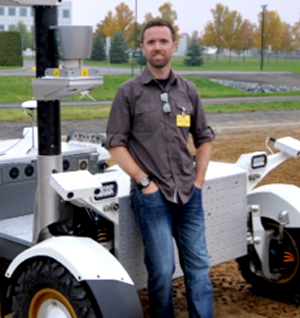Search Papers:
The keynote information for the 4th International Conference of Control, Dynamic Systems, and Robotics (CDSR'17) is as follows:
Dr. Tim Barfoot

Dr. Timothy Barfoot (Professor, University of Toronto Institute for Aerospace Studies – UTIAS) holds the Canada Research Chair (Tier II) in Autonomous Space Robotics and works in the area of guidance, navigation, and control of mobile robots a variety of applications. He is interested in developing methods to allow mobile robots to operate over long periods of time in large-scale, unstructured, three-dimensional environments, using rich onboard sensing (e.g., cameras and laser rangefinders) and computation. Dr. Barfoot took up his position at UTIAS in May 2007, after spending four years at MDA Space Missions, where he developed autonomous vehicle navigation technologies for both planetary rovers and terrestrial applications such as underground mining. He sits on the editorial boards of the International Journal of Robotics Research and the Journal of Field Robotics. He recently served as the General Chair of Field and Service Robotics (FSR) 2015, which was held in Toronto. He is the author of a new book, “State Estimation for Robotics”, in press.
Topic of Keynote: Can a Robot Navigate Using Vision Alone Forever?
Dr. Farrokh Janabi-Sharifi

Farrokh Janabi-Sharifi is a Professor of Mechanical and Industrial Engineering and the Director of Robotics, Mechatronics and Automation Laboratory (RMAL) at Ryerson University, Toronto, Canada. He was elected Fellow of the Canadian Society of Mechanical Engineers (CSME) and also Engineering Institute of Canada (EIC) for his work on image-guided control and robotics.
He received his PhD degree in Electrical and Computer Engineering from the University of Waterloo, Canada in 1995. He was NSERC postdoctoral fellow and instructor in the Center for Intelligent Machines and Department of Electrical and Computer Engineering of McGill University (1995-1997). He has also been Visiting Professor in Technical University of Munich (Germany), INRIA-IRISA (France), and KAIST (Korea). His research interests span over optomechatronic systems with the focus on image-guided control of autonomous robotic systems. He currently serves as the Technical Editor of IEEE/ASME Transactions on Mechatronics, and on the Editorial Board of several journals including International Journal of Optomechatronics, Journal of Robotics, and The Open Cybernetics and Systemics Journal. He also chairs CSME Technical Committee on Mechatronics and MEMS. He has organized several international conferences including International Symposium on Optomechatronic Technologies, ISOT 2010 (Toronto, Canada) and SPIE International Conference on Optomechatronic Systems Control (2005, 2006), and served in Program Committees of more than twenty International Conferences. Among the awards he received were several Best Paper Awards, a German Research Foundation (DFG) Guest Professorship Award, INRIA Visiting Professorship Award, and Dean’s one Teaching Award and two Scholarly, Research and Creative Activity Awards at Ryerson University.
Topic of Keynote: Robotic Interventions: Achievements, Challenges, and Future Prospects
Dr. Hugh H.T. Liu

Hugh H.T. Liu is a Professor of the University of Toronto Institute for Aerospace Studies, where he has been on the faculty since 2000. He currently also serves as the Director of Natural Science and Engineering Research Council of Canada (NSERC) Collaborative Research and Training Experience (CREATE) Program on Unmanned Aerial Vehicles and Centre for Aerial Robotics Research and Education. He received his Bachelor’s degree from Shanghai Jiao Tong University (1991), Master’s degree from Beijing University of Aeronautics and Astronautics (1994), and Ph.D. from the University of Toronto (1998). His research interests in the area of aircraft systems and control include autonomous unmanned systems, cooperative and formation control, fault tolerant control, active control on advanced aircraft systems, as well as integrated modeling and simulations. Prior to his academic appointment, Dr. Liu was a systems engineer at AlliedSignal (now Honeywell) Aerospace Canada where he worked on various aircraft systems projects. He has served many years as a member of the AIAA Guidance, Navigation, and Control Technical Committee. He currently serves as the Associate Editor of AIAA Journal of Guidance, Control and Dynamics. He is also an Associate Editor of the Canadian Aeronautics and Space Journal. Dr. Liu is a fellow of Engineering Institute of Canada, an Associate Fellow of AIAA, a Fellow of Canadian Society of Mechanical Engineers, and a registered Professional Engineer in Ontario, Canada.
Topic of Keynote: Formation Control of Autonomous Vehicles
Dr. John McPhee

John McPhee is the Canada Research Chair in System Dynamics at the University of Waterloo, which he joined in 1992. Prior to that, he held fellowships at Queen’s University, Canada, and the Université de Liège, Belgium.
Dr. McPhee pioneered the use of linear graph theory to model multi-domain dynamic systems, with applications ranging from autonomous vehicles to rehabilitation robots. His research algorithms are a core component of the MapleSim software, which is used by thousands of engineers and researchers at Toyota, NASA, Ford, Canon, Moog, and many others. He is particularly interested in the dynamics and model-based control of biomechatronic systems, and the use of symbolic computing to develop real-time simulations and controllers. His research partners include Maplesoft, Toyota, the Canadian Space Agency, the Toronto Rehabilitation Institute, Cycling Canada, Magna, Cleveland Golf, and the Canadian Sport Institute.
Dr. McPhee is the Chair of the International Association for Multibody System Dynamics, a co-founder of 2 journals and 3 international technical committees, and an Associate Editor for 6 leading journals in his field. He has had the pleasure of supervising 83 outstanding graduate students and postdoctoral fellows.
Dr. McPhee is a Fellow of the Canadian Academy of Engineering, the American Society of Mechanical Engineers, the Engineering Institute of Canada, and the Canadian Society of Mechanical Engineers. He has won 4 Best Paper Awards and, in 2014, he received the prestigious NSERC Synergy Award from the Governor-General of Canada.
Topic of Keynote: Model-based Dynamics and Control: from Cars to Biomechatronics
© Copyright 2017, International ASET Inc. - All Rights Reserved.
ISSN: 2368-5433 | ISBN: 978-1-927877-38-8

